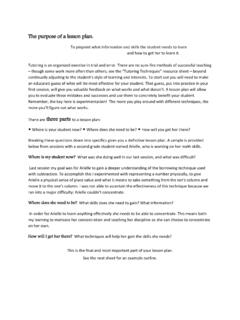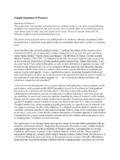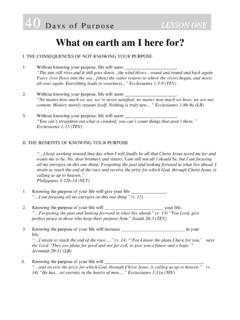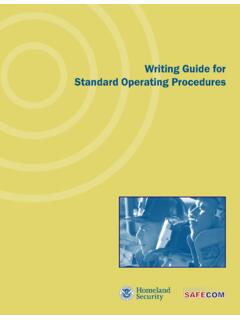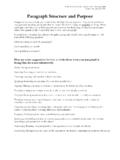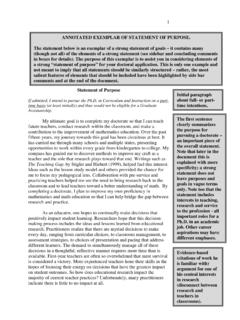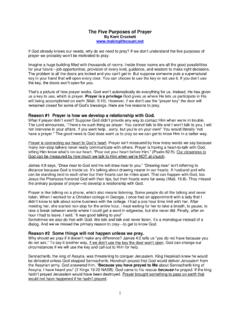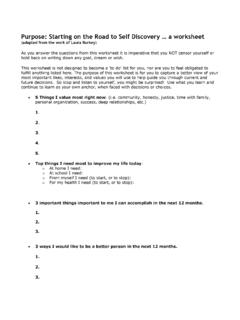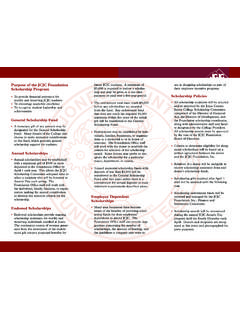Transcription of “Author’s Purpose & Point of View” Author’s Purpose author ...
1 author s Purpose & Point of view Another area that the Reading tests is the author s Purpose and Point of view . This portion of the test measures your ability to determine the reason why the author is writing the article and how their experiences or beliefs are impacting their writing. author s Purpose All authors have a reason why they write what they do. This is called the author s Purpose . Since all authors have experiences or beliefs that influence the way that they write they also have a Point of view . There are four main reasons why people write: P = to Persuade (goal- to convince the reader) I = to Inform (goal- to state the facts) E = to Entertain (goal- to make us laugh, cry, scream, have fun) S = to Share a personal experience (goal- to share memories, hopes or dreams) There are some clues that help you to determine for which reason the article was reason.
2 Persuade When authors write to persuade they are trying to get the reader to do something: 1) THINK: believe what they are saying or change your mind; 2) ACT: buy a certain product or join a club; 3) FEEL: know what someone else is feeling; Examples of types of persuasive writing: letters, speeches, advertisements and editorials. Inform When authors write to inform they are presenting facts about a subject. This type of writing has: 1) No opinionated statements (only facts); 2) No implied suggestions; 3) The reader learn about something; Examples of types of informative writing: newspapers, encyclopedias, dictionaries and pamphlets. Entertain When authors write to entertain they want us to enjoy the writing.
3 Sometimes they make us laugh with a funny story, make us cry with a sad story or poem, or scream because of a scary experience of one of the characters. With this Purpose , authors just want us to have fun reading. Share a Personal Experience When authors write to share a personal experience they are sharing their memories, hopes or dreams. Some key signs that an article is a personal experience is: 1) the story is about the author or some other personal story; 2) the writer shares his full opinion; 3) the story is usually written in first person (I, me, us); Examples of types of personal writing: letters, diaries, personal essays or articles. You must read the entire article to determine the author s Purpose .
4 Sometimes an author may have more than one Purpose . author s Point of view The author s Point of view reveals the author s beliefs, personal judgments or attitudes toward a certain subject. There are devices that the author uses to reveal their beliefs: 1) choice of words; 2) descriptions; 3) character s actions 4) what is not in the text; 5) choice of details; Understanding the author s Point of view helps us to determine where the author is coming from and whether or not we should consider what the author has to say. Skills Practice 1. What is the author s Purpose ? Give details to support your answer. _____ _____ _____ _____ Coyotes Invade Downtown The discovery of a wild coyote in late 1997 in the Henry M.
5 Jackson Federal Building in downtown Seattle should come as a wake-up call. The United States has a serious coyote problem! From their traditional enclaves in the western desert, these opportunistic canines have now invaded the entire continental United States. They have taken over parks, farms, vacant lots, and now perhaps the downtown areas of major cities. Homeowners report losing cats and dogs to the beasts, and young children are under attack. Enough is enough. Since humans are the only natural enemy of coyotes, we demand that state and federal agencies institute coyote trapping programs. That is the only way to decrease the number of coyotes to a manageable level. 2.
6 What is the author s Point of view ? How can you tell? _____ _____ _____ _____ 3. Why did the author arrange the lines of the poem so that Dr. Womback s needle was mentioned before the nurse who held the needle? A. The author was just trying to rhyme with the word burst. B. The author wanted to show how a child would view the situation. C. The author wanted to frighten his readers with a scary vision. D. The author wanted to convince readers that the needle was huge. Dr. Womback s Needle By Brod Bagert There ll be footsteps any second now And through the door they ll burst, Dr. Womback s needle In the hands of Dr. Womback s nurse!
7 Now this will pinch a little, she ll say As I see the shiny steel Of a fifteen-foot-long needle She claims I ll hardly feel. Someday I ll be big and strong And she couldn t hurt me if she tried, But now---I m just a little And I think I m gonna cry. 4. What was MOST LIKELY the author s Purpose for describing Dr. Womback s needle as fifteen-foot- long ? A. to show how frightening the needle looked to the child B. to show how long the needle actually was C. to match the rhythm and rhyme scheme of the poem D. to show how big needles used to be in the old days 5. What is MOST LIKELY the author s Purpose for writing this poem? a. to frighten children about getting shots b.
8 To make fun of a small, frightened child c. to inform readers about the fears of small children d. to entertain readers with a child s viewpoint points to remember: o An author s Purpose is usually to persuade, to entertain, to inform, or to share an experience; o Everybody writers as well as readers- has a Point of view ; o A Point of view is a personal attitude that affects the way someone interprets the world; o Point of view can influence the way an author writes, the words he or she chooses, the actions and descriptions of characters, the conclusions drawn, etc. Good Luck!


